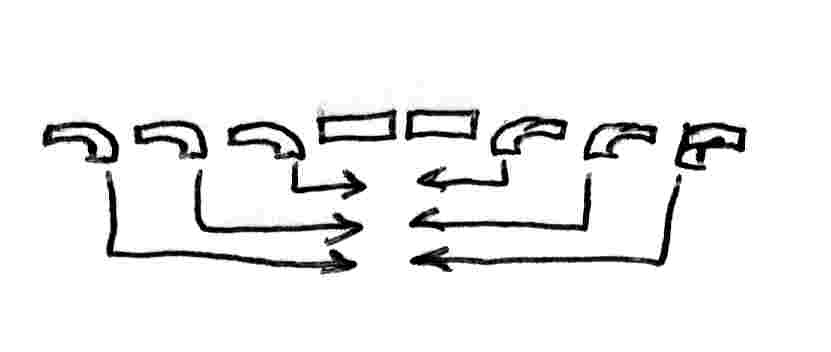
Maneuver of the Month (September 2004)
Battalion: Moving from a line to a double column, and back again

One of the items from the August 21st officer /NCO school is that we will add another battalion maneuver to our repertory: Moving from a battalion in line to a double column of companies, called a "column doubled on the center", and back again.
I saw another battalion do this at Raymond in 1997, and it was a pretty spectacular maneuver, the one time I've seen someone do something our battalion had never done. They were in four companies, approached the enemy in column (two companies wide, two companies deep), and suddenly the rear companies popped out into line and they attacked. We, too, will prepare to do this. But at Franklin this year the Red River Battalion has more companies falling in with us, so we will have ten companies and we'll be even more spectacular.
This is easiest to do when the line is moving forward: If you begin with a line moving forward, the Colonel's command is "Double column at half distance. Battalion, by the right and left flanks, MARCH."
At "MARCH" the color guard return from their position marching six paces in front, to their place in ranks. The center two companies continue to march forward, while the other companies fall in behind. This requires that the right wing (except the color company) do a "by the left flank, march"; and the left wing (except for the color company's neighbor) do a "by the right flank, march".
As each pair of companies unite at the center, the commander of the right hand one orders "_____ company, by the right flank, march"
And the commander of the left hand one orders "____ company, by the left flank, march". This will put both companies marching forward, side by side, which also clears the way for the next pair to unite behind them.
If there is an odd number of companies, the odd company falls in on its wing's flank, usually the left.

The pairs of companies are called "divisions". The senior captain in each division steps out in front, takes command and command "Guide right." The junior captain moves into ranks in front of the first sergeant of the left hand company, which should put him in the center of the division.
To get back out of the doubled column into a line while moving forward, the Colonel commands: "Deploy column. Battalion by the right and left flanks, double quick, march." He adds: "Guide center" at which the colors step out six paces in front, and the commanders of the two leading companies move to the outer flanks of their companies while these two companies continue forward at quick time. The other companies move to their flanks at the double quick and then guide into the moving line.

If the battalion is not moving, there is a more complex method for forming the double column at a halt. The Colonel's command is "Double column, at half distance, Battalion, inwards-face. March." The two center company commanders warn their companies to stand fast, while the other company commanders warn their companies to face left or right as appropriate. The other (non-center) companies will break to the rear, just as you do in "by the right of companies to the rear into column."

At "March" the outer companies march toward the rear and their commanders guide them by the shortest route to go back the proper interval and unite into divisions. Just before they meet, the 2nd sergeants step out into the rank of file closers one pace behind where their companies will end up. Each company commander orders "___ company, halt, Front."
To deploy from a halt, the battalion commander posts three markers in front of the leading division and then has the general guides post where the battalion's flanks will be. He then commands: "Deploy column. Battalion outwards-face. March."
The leading division stands fast and the other companies face outward and deploy as already explained above. Each company supports arms when the neighboring company that enters the line after it has dressed on the line. When all are dressed the Colonel commands, "guides-posts."
All this is explained in Hardee's second volume, paragraphs 776 through 802.
Ian Straus